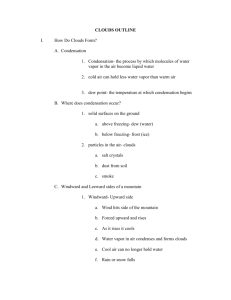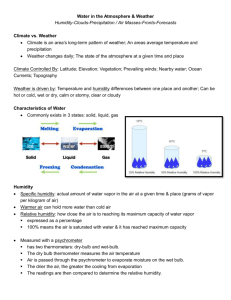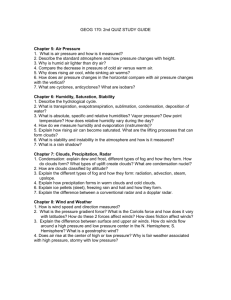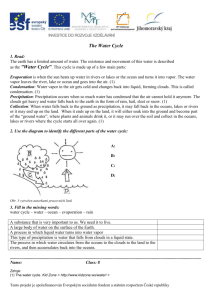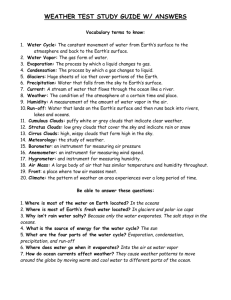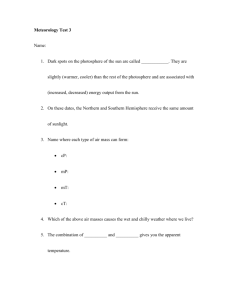Chapter 18 WATER IN THE ATMOSPHERE
advertisement
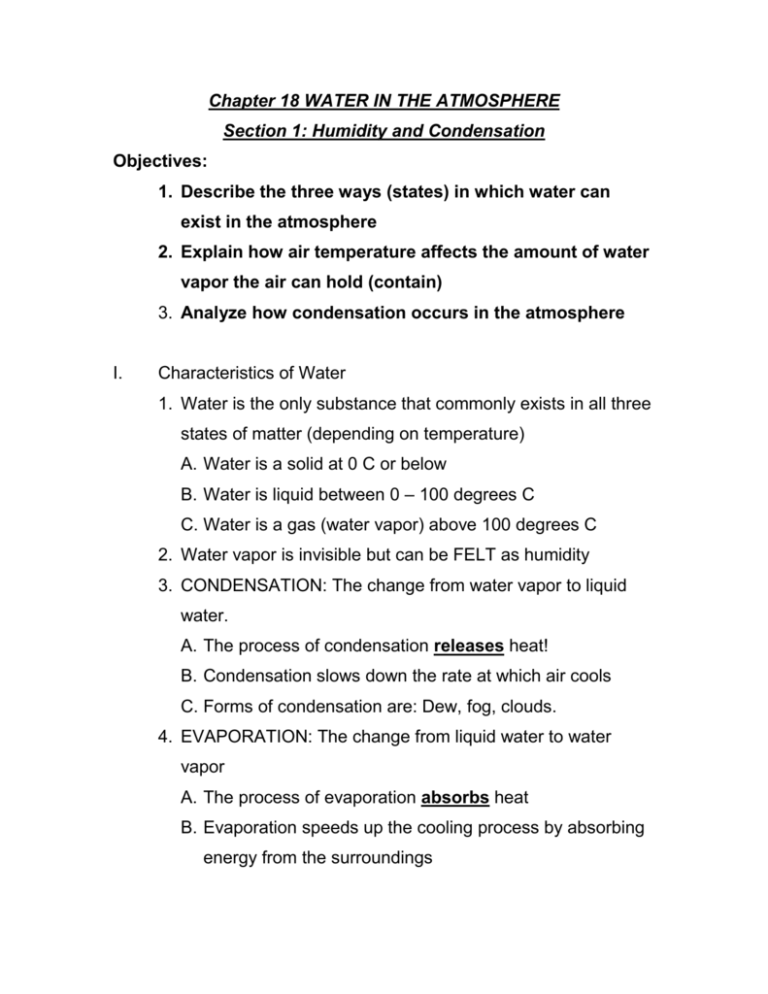
Chapter 18 WATER IN THE ATMOSPHERE Section 1: Humidity and Condensation Objectives: 1. Describe the three ways (states) in which water can exist in the atmosphere 2. Explain how air temperature affects the amount of water vapor the air can hold (contain) 3. Analyze how condensation occurs in the atmosphere I. Characteristics of Water 1. Water is the only substance that commonly exists in all three states of matter (depending on temperature) A. Water is a solid at 0 C or below B. Water is liquid between 0 – 100 degrees C C. Water is a gas (water vapor) above 100 degrees C 2. Water vapor is invisible but can be FELT as humidity 3. CONDENSATION: The change from water vapor to liquid water. A. The process of condensation releases heat! B. Condensation slows down the rate at which air cools C. Forms of condensation are: Dew, fog, clouds. 4. EVAPORATION: The change from liquid water to water vapor A. The process of evaporation absorbs heat B. Evaporation speeds up the cooling process by absorbing energy from the surroundings C. Form of evaporation is sublimation !DIAGRAM ON PAGE 391! II. Humidity 1. Specific Humidity: The actual amount of water vapor in the air at a given time and place. Expressed as grams per kilogram of air. 2. Humidity is limited to air temperature. Temperature and water vapor in the atmosphere are positively correlated. A. As temperature increases the amount of water vapor the air can hold increases, as temperature decreases, the amount of water vapor the air can hold decreases. 3. Relative Humidity: A. How close the air is to capacity for holding water vapor (%) B. To calculate the relative humidity of a kilogram of air, divide the specific humidity by the capacity C. WORKSHEETS!!!! 4. Measuring Humidity A. Measured with a psychrometer a. wet bulb and dry bulb: evaporation = cooling therefore the difference in the temperature between the wet bulb reading and the dry bulb reading when compared on a chart will give the relative humidity of the air. b. CHART ON PAGE 393! III Condensation: 1. Cooling and Condensation A. In order for condensation to occur, the air must be cooled to it’s dew point, AND there needs to be something onto which the water vapor can condense (CONDENSATION NUCLEI) B. Air becomes supersaturate if the water vapor has nothing on which to cool C. Air cools in several ways: a. contact with a colder substance/surface (DEW/FROST) b. radiation of heat (radiational cooling) (DEW/FROST) c. mixing with colder air (FOG) d. expansion as it rises (ADAIBATIC LAPSE RATE) 2. Formation of Dew and Frost A. When air cools to it’s dew point through contact with a colder surface, water vapor will condense directly on to that surface. a. Ground and surfaces near the ground become cooler more quickly because they lose heat more rapidly than air does. b. Dew = above 0 degrees C c. Frost = DEPOSITION of water vapor when atmospheric temperatures are below 0 degrees C 3. Formation of Fog A. When a cold surface cools the warm, moist air directly above it B. Radiation Fog: Radiational cooling causes the air directly above the surface to cool. Light winds mix this cool air with the warmer air above it cooling it to it’s condensation (dew) point a. the fog at ground level is cooler than the warmer air directly above it so a temperature inversion takes place b. common near lakes and rivers and most frequent in late fall and winter. C. Advection Fog: When warm moist air blows over a colder surface. a. When warm air blows over a snow covered area. Chapter 18: WATER IN THE ATMOSPHERE Section 2: Clouds Objectives: 1. Describe the three basic forms of clouds 2. Explain how the shape of a cloud shows how the air is moving through it I. Types of Clouds 1. There are 4 types of clouds: low, middle, high, and clouds with vertical development 2. Clouds are classifies according to their HEIGHT and SHAPE A. HEIGHT: low, middle, high B. SHAPE: Vertical – layer or stratiform clouds Horizontal – great puffs, or cumuliform clouds 3. Cloud distances are measured above the ground, not above sea level. 4. Cloud names are formed from one or more of the same five words or word parts: A. Stratus/ Strato = layer clouds B. Cumulus/ Cumulo = vertical clouds C. Cirrus/ Cirro = feathery clouds D. Alto = clouds that are between 2000 and 7000 meters E. Nimbus/ Nimbo = dark rain clouds II. Cloud Formation 1. Background of cloud formation: A. The shape of a cloud shows how air moves through it. B. Where (at what altitude) the cloud forms tells you where the condensation level is, or where air reaches it’s saturation point and the water vapor condenses as liquid water. 2. Dry and Moist Adiabatic Lapse Rates A. The adiabatic lapse rate is the rate at which air cools as it rises a. Unsaturated (dry) air cools more quickly than saturated air. This occurs because condensation of water from water vapor causes/releases heat. b. Air cools as it rises because the air is expanding due to decreased pressure. c. The Dry Adiabatic Lapse Rate = 10 degrees per kilometer while the Moist Adiabatic Lapse Rate = 5-9 degrees per kilometer. 3. Cumulonimbus Clouds (vertical rain clouds) A. Cumulonimbus clouds begin forming when moist air rises and cools to it’s dew point, the cloud base will form at the condensation level. B. THE SUMMARIZATION OF THIS CONCEPT IS SHOWN IN THE PICTURE ON PAGE 399!!!!! (if you understand the picture and the captions than you understand the major concept of the formation of cumulonimbus clouds) 4. Layer Clouds A. Form in stable air because it does not easily move up or down it will spread out vertically B. Clouds form in stable air in two ways: a. Air can be forced slowly upward to it’s condensation level (when it moves up a mountain, or when it moves over a layer of colder, denser air) b. By radiating heat into the atmosphere or mixing with cooler air which causes it to cool to it’s dew point and form clouds. 5. Predicting the Condensation Level A. Predicting the condensation level of an air mass involves two things: cooling and dew point. a. As the warm air rises, both it’s temperature and dew point will decrease! Therefore if you have the temperature and dew point of an air mass at ground level you can predict the condensation level by considering two laws of nature: 1. Temperature of a dry air mass will drop 10 degrees per kilometer gain of altitude (dry adiabatic lapse rate) 2. The dew point will drop 2 degrees for every kilometer gained in altitude. WHEN THE TEMPERATURE OF THE AIR MASS AND THE DEW POINT ARE THE SAME, THAT IS THE ALTITUDE AT WHICH CONDENSATION WILL OCCUR! b. This information helps meteorologists predict if storms will occur as well as how severe the storm may be Chapter 18: WATER IN THE ATMOSPHERE Section 3: Precipitation Objectives: 1. Compare and contrast how precipitation forms in warm clouds and cold clouds 2. Describe how rising air produces precipitation I. How Precipitation Forms 1. Growth of water droplets A. By bumping into one another and combining B. The longer a droplet has been in a cloud, the bigger it will be due to more time to combine with other droplets C. Droplets will also range in size due to the condensation nuclei on which they form 2. Growth of ice crystals A. Ice crystals present in the upper, colder portion of clouds. Ice crystals grow when they come in contact with other ice crystals or through deposition of ice onto the ice crystals from the water vapor in the clouds. (super-cooled water droplets) 3. Kinds of Precipitation A. Drizzle B. Rain C. Snow D. Sleet E. Freezing rain F. Hail II. Measuring Precipitation 1. Rain is reported to the hundredths of an inch 2. Snow is reported by melting it then reporting III. Where Does Precipitation Occur? 1. The warmer the air before it rises, the more moisture it can contain, the higher the air rises, the more moisture it can release 2. Kinds of areas where precipitation is common: A. Equator B. In storm areas of all kinds C. Mountain ranges a. moist air is pushed up a mountain range from wind, it cools and condenses in the form of rain or snow. D. (USUALLY ANYWHERE THE AIR IS FORCED TO RISE) E. It doesn’t rain anywhere the air sinks IV. Weather Modification 1. Cloud “seeding” SUMMARY OF KEY IDEAS 18-1 1. Water exists in the atmosphere as a solid liquid and gas 2. Evaporating water absorbs heat from it’s surroundings which become cooler 3. Condensing water releases heat to it’s surroundings 4. Warmer air can contain more water vapor than cooler air 5. Fog and clouds form when air is cooled to it’s dew point and water vapor in the air condenses around condensation nuclei 6. Dew or frost forms if contact with cold ground cools air to it’s dew point 18-2 1. Clouds are classified by their height above ground and their shape 2. Cumuliform clouds are formed by rising air and stratiform clouds form in horizontal layers 3. Rising air cools at the dry adiabatic lapse rate with no condensation and the moist adiabatic lapse rate with condensation 4. Heat released through condensation within a cloud can cause the air within the cloud to rise to great heights. 18-3 1. Water droplets in clouds grow by colliding with each other 2. Ice crystals in clouds grow through collisions and by using water vapor that evaporated from super-cooled drops. 3. Precipitation’s type depends on the conditions as it forms and falls.

